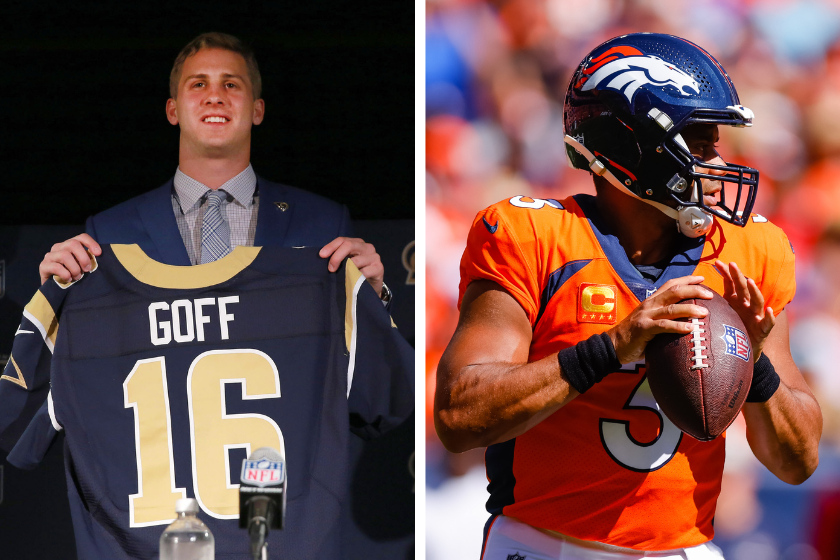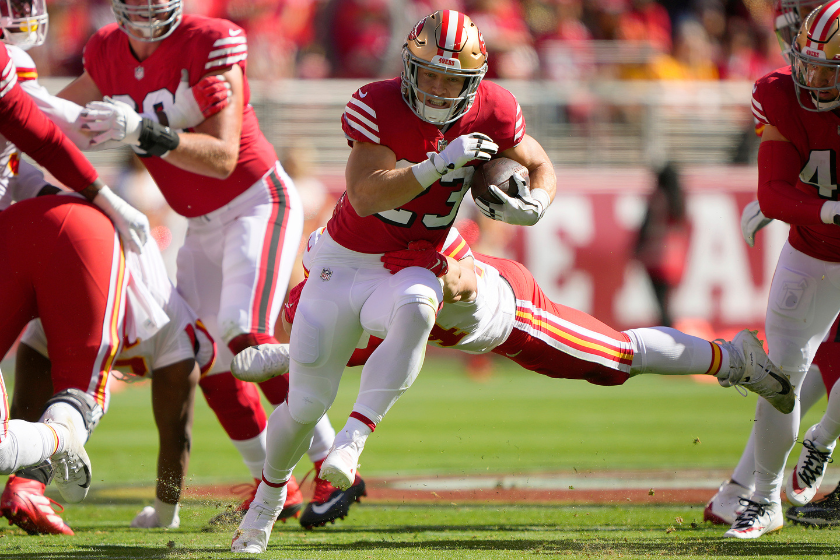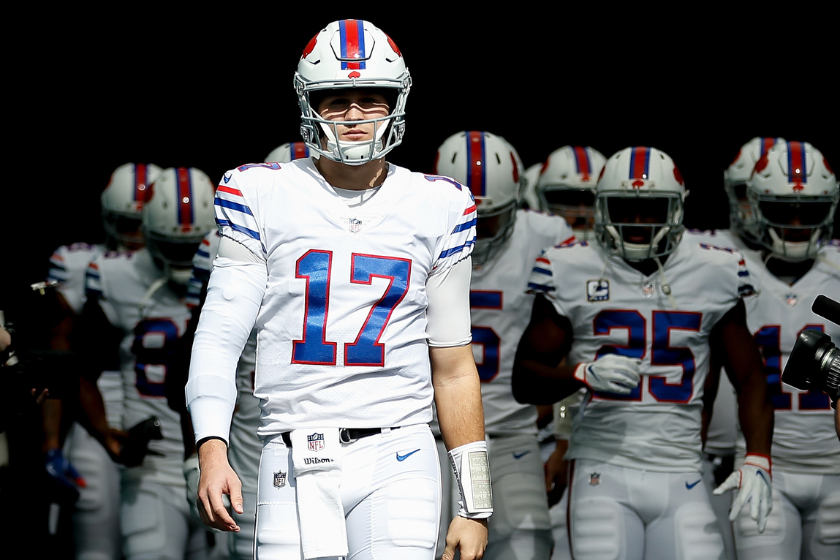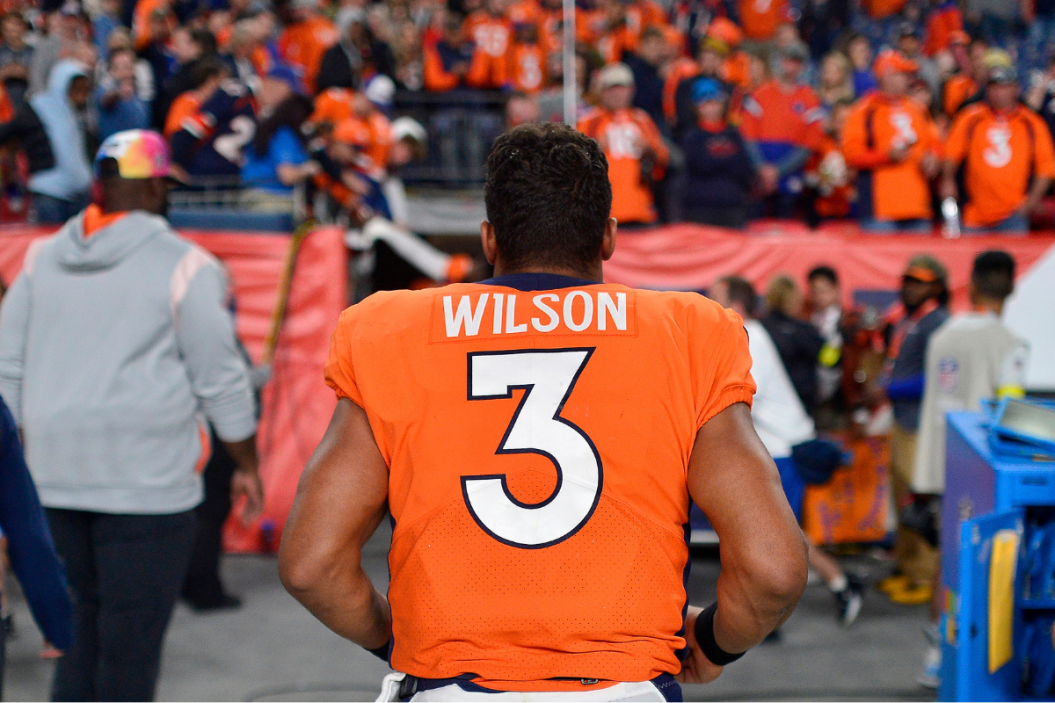Trading future assets for current talent is a precarious business in the NFL. Knowing when to go all in with a current roster and when to hold onto or accumulate more resources is why the role of a NFL GM is one of the most critical in all of sports.
Videos by FanBuzz
Sometimes, like in the case of the 2021-22 Los Angeles Rams, you sell the farm and it works. Relinquishing two first rounders, a third rounder, and Jared Goff to the Detroit Lions was worth it, because trading those assets acquired Matthew Stafford, who brought home a Super Bowl trophy for LA. Mortgaging those picks for the Rams' run to the title worked so well, the team's GM Les Snead wore a shirt reading "F*** Them Picks" to the Super Bowl parade. Everything went perfect for the Rams. Or did it?
When Making Big Deals Goes Wrong

Left:Photo by Victor Decolongon/Getty Images, Right: Photo by Justin Edmonds/Getty Images
RELATED: The Colorado Rockies Have Drafted Better QBs Than the Denver Broncos. Seriously.
In order to trade up and draft Jared Goff in the first place in the 2016 draft, the Rams had to swap first rounders with the Titans and throw in five additional picks, including two second rounders and the following year's first round pick. This is what it costs when you want to move up to number one overall. That means in total, acquiring Goff in 2016 and then getting rid of him to bring Stafford to LA cost the Rams roughly 8 additional picks, 5 of which were in the top 2 rounds, AND Goff himself. Oh yeah, and one of those picks became Titans All-Pro running back Derek Henry. Sounds like a pretty steep price to pay.
Of course winning a title is the ultimate goal, so maybe it really did work out, but the risk is high and we will never know if the Rams could have achieved similar and more sustainable success without risking future assets and cap space multiple times. After all, Goff and the Rams did reach the Super Bowl in 2019 and we don't yet know if this current Rams team can maintain the level of success they showed last season.
Not having a first round choice eliminates the small silver lining that can come with a terrible start to the NFL season. There is no worse spot to be in as an organization, or worse feeling as a fan, than when your team underperforms and that glimmer of draft day hope has already been taken away. Five NFL teams traded away their first round picks in 2023, including the Rams as part of that deal for Matthew Stafford. Of those 5 teams, the Browns, Broncos and Saints would all have traded away selections within the top six picks if the season ended today.
What you give up when you trade a future first or second round pick is even higher when you think about the opportunity cost. For example, let's take this off-season's blockbuster trade the Broncos made with the Seahawks to acquire quarterback Russell Wilson.
The trade for Wilson cost the Broncos three players (two of them on inexpensive rookie deals), four top two round picks, and a new contract extension for Wilson that is $53.5 MILLION DOLLARS MORE than his replacement Geno Smith is making this season. Wilson's contract locks up a lot of money that the Broncos can't spend on other areas of their roster each year. Remember in a salary cap league like the NFL, opportunity cost is a big factor, because each dollar you spend on one player is a dollar that can't go to someone else.
Then you have to lump in the fact that all first-round picks come with a fifth-year team option as part of their rookie deals. That means the Broncos gave up 18-years of cumulative player control of top caliber prospects from the 2022 and 2023 draft. Those are the years when top prospects are at their most reasonable salary levels, especially if they pan out.
Selling Your Future for a Hopeful Present

Photo by Thearon W. Henderson/Getty Images
RELATED: Christian McCaffrey Makes the San Francisco 49ers the Scariest Team in the NFC
Another team to keep an eye on when it comes to leveraging future draft capital is the San Francisco 49ers. The 49ers swapped picks in the first round of the 2021 draft with the Miami Dolphins to move up and select quarterback Trey Lance. San Francisco traded away its first and third round picks in 2022 and its first round pick in 2023 as part of the deal.
Additionally, this past week the 49ers sent 2023 second, third and fourth round picks to the Panthers to acquire running back Christian McCaffrey. Along with this trade comes McCaffrey's 16 million dollar per year salary, the highest for any running back in the league. In total, we are talking about 7 picks and 30 cumulative years of prospects under contract control just to acquire those two players. Oh and one of those picks swapped for Trey Lance... it was already used to select first-team All-Pro Micah Parsons.
This is such a depletion of cap space and assets for San Francisco that it has ESPN writer Bill Barnwell posing the question, 'should the 49ers consider trading wideout Brandon Aiyuk or even Lance himself, to try to refill their draft day coffers?'
Tipping the Pay Scale

Photo by Michael Reaves/Getty Images
Since the rookie wage scale was implemented as part of the 2011 collective bargaining agreement, many of the most successful teams in the league have focused on maximizing the value of great players while they are on relatively inexpensive rookie deals. They prioritize surrounding them with high value veterans that fit their system and that the free agency market has undervalued.
That rookie pay scale is one of the reasons why moving up in the draft to select a marquee quarterback on a rookie deal has been strongly advocated for and executed successfully by teams like the Kansas City Chiefs with Pat Mahomes and the Buffalo Bills with Josh Allen. It's also why success will likely become more difficult for the Bills starting next year, when the impact of Allen's 6-year $258 million dollar contract extension really begins to be felt on Buffalo's salary cap.
But you have to choose wisely when you leverage your future assets, because you have so much more hanging in the balance than just the performance of one high-end prospect. And for every Mahomes and Allen, there are many more Mitch Trubiskys, Carson Wentzs , Trent Richardsons, Josh Rosens, Kyler Bollers and Johnny Manziels.
The reality is this is the NFL and if a team wants to compete at the highest level, they have to tirelessly continue to acquire talented players, and pay for the talented ones that they already have. In a league where a player's fit on a team, based on both scheme and surrounding personnel, is so critical, an organization must be certain with their evaluations and careful when they make any significant commitments of future cap space and future draft capital.
Anyone you are trading future assets for has to fit both with what your team's philosophy and scheme are now, and what they will continue to be down the line should any organizational changes occur. Because if they don't, or if your team evaluates poorly, you will likely feel the impact for years to come. Proceed with caution.
